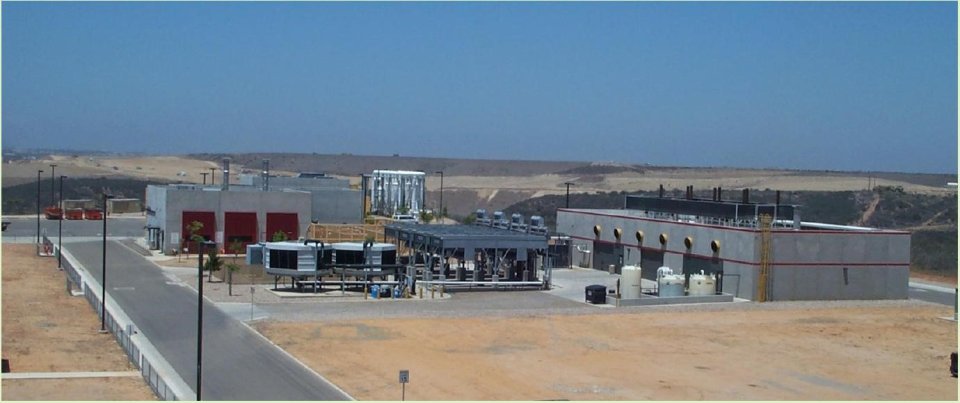Generate LFG Electricity for Microgrid
As costs for energy storage have come down, electricity generated from landfill gas (LFG) can be stored as part of a microgrid system. A microgrid:
- Is an independent and self-sufficient local distributed energy system that can provide electricity directly to a defined set of end users.
- Often includes energy storage components to provide backup power.
- Can be connected to a larger grid system for additional reliability.
- Can include electric vehicle charging stations if there is demand for electrical fleets within the region served by the grid.
Criteria:
- Project is in an area with favorable energy storage policies such as behind-the-meter storage or net metering for grids that are connected to larger grid systems.
Pros:
- Energy storage can supplement traditional power resources and serve as a backup power source during outages.
Cons:
- Microgrid technologies are relatively new and are evolving, so there is a lack of standards and regulations regarding the best ways to synchronize them with the main power grid and inconsistency as to whether they should be classified as electrical utilities. These complications can make it unappealing to develop microgrids due to uncertainty and potentially high costs.
- Utilities may be resistant to microgrid construction as this may cut into their revenue.
- Microgrids can also face challenges related to management, safety and protection.
Economic Considerations:
- Battery storage costs are $550 to $560 per kilowatt-hour (kWh) for total installed cost and $83 per kilowatt (kW) per year in operation and maintenance costs.1 Projected future installed costs are $94 per kWh in 2024 and $62 per kWh in 2030.1
- Additional costs are for smart interconnection, controllers, and other infrastructure.
More Information:
- Microgrids, U.S. Department of Energy (DOE)/National Renewable Energy Laboratory (NREL)
- Microgrids for Energy Resilience: A Guide to Conceptual Design and Lessons from Defense Projects, U.S. DOE/NREL
- Phase I Microgrid Cost Study: Data Collection and Analysis of Microgrid Costs in the United States, U.S. DOE/NREL
- Community Microgrids: A Guide for Mayors and City Leaders Seeking Clean, Reliable and Locally Controlled Energy, Microgrid Knowledge
- Webinar: Landfill Gas Electricity Power Purchase Agreement Ending Soon? Learn What You Can Do, EPA LMOP
References
1 NC Clean Energy Technology Center. Energy Storage, Electric Vehicles & EV Charging. 21st Century Strategic Direction: Comprehensive Study and Key Considerations. March 31, 2020. https://nccleantech.ncsu.edu/wp-content/uploads/2020/05/21st-Century-Integrated-Electric-Resource-Study-Final-DO-NOT-EDIT-MOC-.pdf.
2 Giraldez, Julieta, et al. U.S. Department of Energy. National Renewable Energy Laboratory. Phase I Microgrid Cost Study: Data Collection and Analysis of Microgrid Costs in the United States. NREL/TP-5D00-67821. October 2018. https://www.nrel.gov/docs/fy19osti/67821.pdf.
3 U.S. EPA. LMOP Landfill and Landfill Gas Energy Project Database. July 2021. https://www.epa.gov/lmop/lmop-landfill-and-project-database.
4 Purtee, Ray. City of San Diego. Miramar Landfill Gas Utilization Enabling the First Green Marine Corps Facility. January 23, 2014. https://www.epa.gov/sites/default/files/2016-05/documents/27_purtee.pdf.
5 Dockery, Col. Charles. Opinion: Miramar’s Innovative Microgrid Supports National Defense and Our San Diego Neighbors. June 17, 2021. https://timesofsandiego.com/opinion/2021/06/17/miramars-innovative-microgrid-supports-national-defense-and-our-san-diego-neighbors/ . Accessed December 17, 2021.
6 Wood, Elisa. Microgrid Knowledge. Miramar Microgrid to Demonstrate One Solution to World’s Waste Problem. February 8, 2019. https://www.microgridknowledge.com/google-news-feed/article/11429923/miramar-microgrid-to-demonstrate-one-solution-to-world8217s-waste-problem. Accessed June 30, 2023.
7 Howland, Ethan. Microgrid Knowledge. Schneider Electric, Black & Veatch Finish Miramar Microgrid. March 16, 2021. https://www.microgridknowledge.com/editors-choice/article/11428191/schneider-electric-black-veatch-finish-miramar-microgrid. Accessed June 30, 2023.
8 Wasco, Mick. Marine Corps Air Station Miramar. Email correspondence. March 17, 2023.

